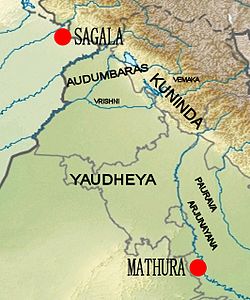Audumbaras | |||||||
|---|---|---|---|---|---|---|---|
| 5th century BCE–4th century CE | |||||||
Coin of Dharaghosha, king of the Audumbaras, in the Indo-Greek style, circa 100 BCE.[1]
Obv: Standing figure, probably of Vishvamitra, Kharoshthi legend, around: Mahadevasa Dharaghoshasa/Odumbarisa "Great Lord King Dharaghosha/Prince of Audumabara", across: Viçvamitra "Vishvamitra". Rev: Trident battle-axe, tree with railing, Brahmi legend identical in content to the obverse.[1] | |||||||
Location on the Audumbaras and contemporary South Asian polities circa 150 CE.[2] | |||||||
 | |||||||
| Capital | Hoshiarpur | ||||||
| Religion | Hinduism | ||||||
| Government | Monarchy | ||||||
| History | |||||||
• Established | 5th century BCE | ||||||
• Disestablished | 4th century CE | ||||||
| |||||||
The Audumbras, or Audumbaras (Hindi;ओदुम्बर) were a north Indian tribal nation east of the Punjab, in the Western Himalaya region. They were the most important tribe of the Himachal, and lived in the lower hills between Sirmaur, Chamba and Yamuna.
- ^ a b Ancient India, from the earliest times to the first century, A.D by Rapson, E. J. p.154 [1]
- ^ Schwartzberg, Joseph E. (1978). A Historical atlas of South Asia. Chicago: University of Chicago Press. p. 145, map XIV.1 (d). ISBN 0226742210.
![Coin of Dharaghosha, king of the Audumbaras, in the Indo-Greek style, circa 100 BCE.[1] Obv: Standing figure, probably of Vishvamitra, Kharoshthi legend, around: Mahadevasa Dharaghoshasa/Odumbarisa "Great Lord King Dharaghosha/Prince of Audumabara", across: Viçvamitra "Vishvamitra". Rev: Trident battle-axe, tree with railing, Brahmi legend identical in content to the obverse.[1] of](http://upload.wikimedia.org/wikipedia/commons/thumb/1/10/Coin_of_Dharaghosha_king_of_the_Audumbaras.jpg/300px-Coin_of_Dharaghosha_king_of_the_Audumbaras.jpg)
